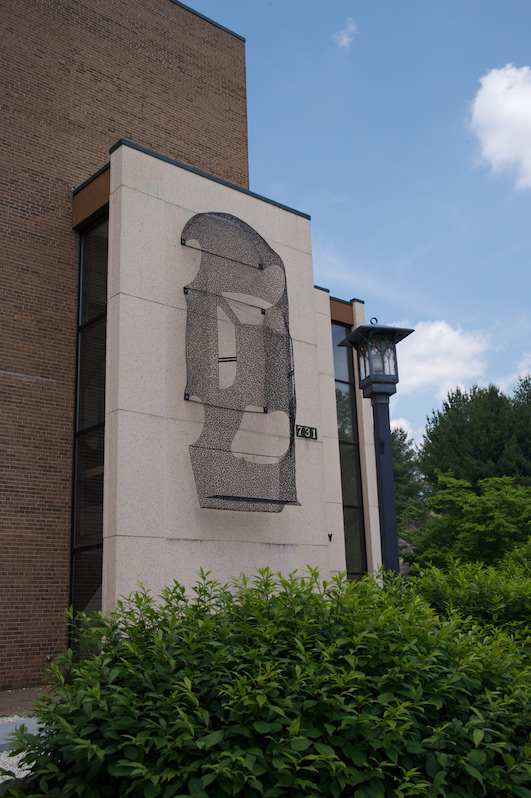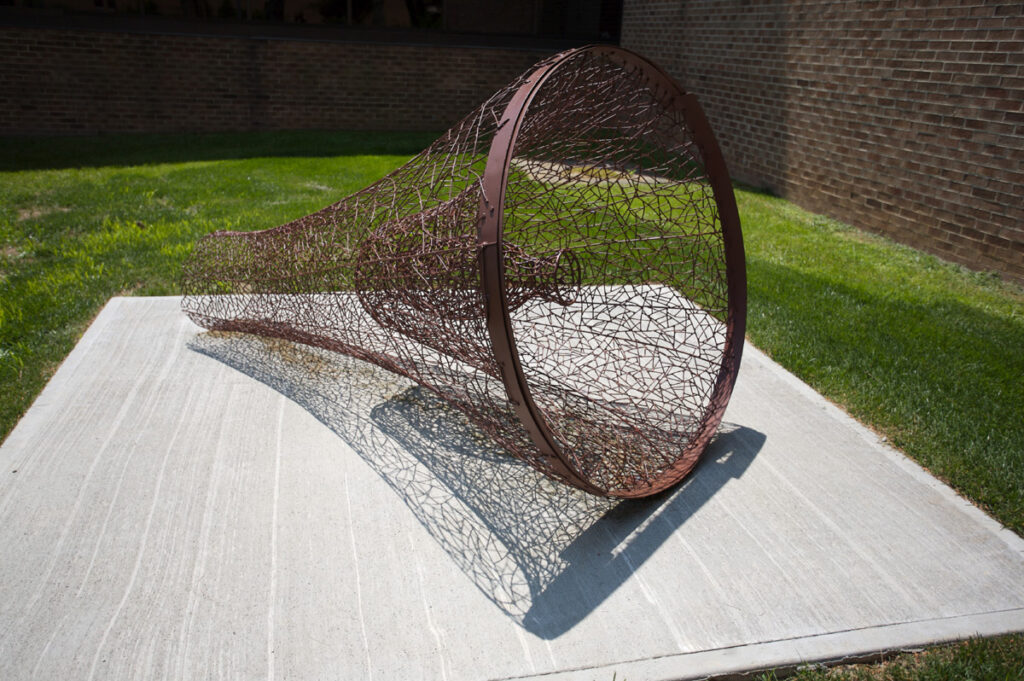Juror: Shannon Fitzgerald
Curator: Hank T. Foreman
Assistant Curator: Brook Bower
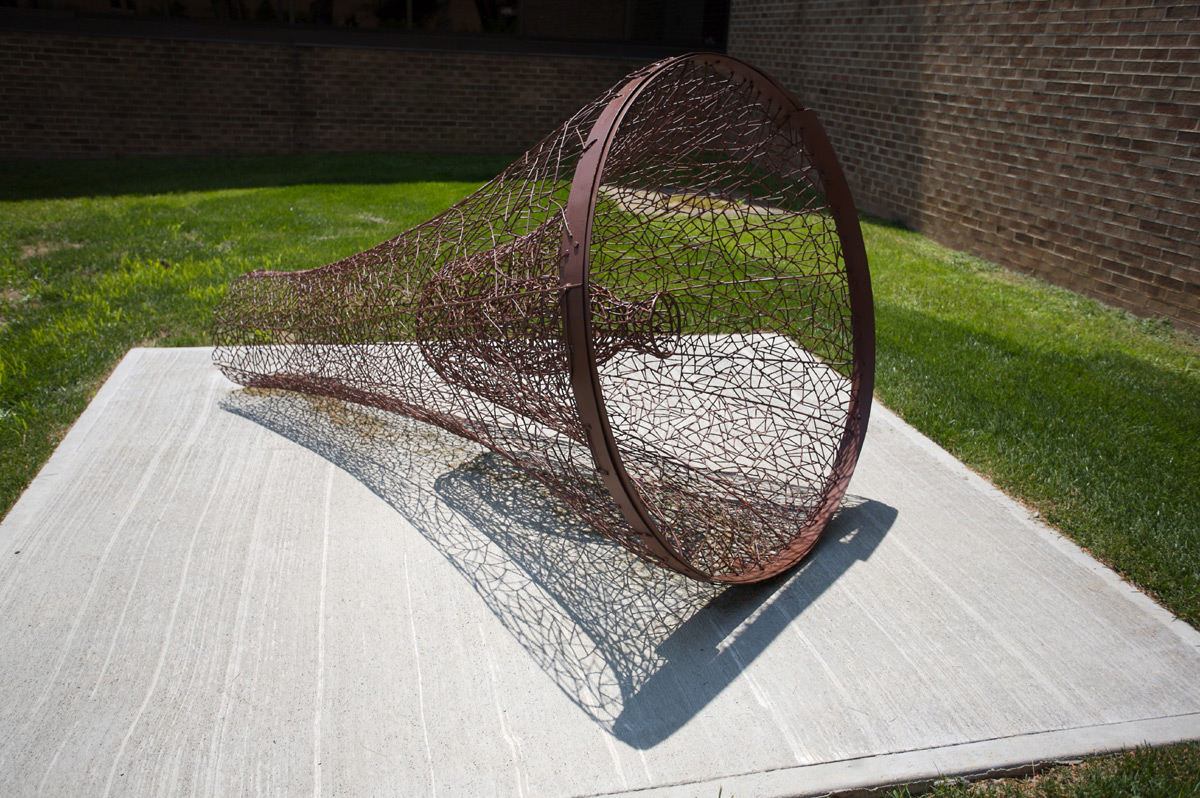
Jonathan Hils, Innate. 2007 / 21st Rosen Sculpture Competition Winner.
Sculptures
-
Right Turn / Innate1st Place
Right Turn / Innate
Jonathan Hils
Norman, Oklahoma
Welded and painted steel
18′ 6″ x 7′ x 5′ / 8′ 6″ x 5′ x 5′
Artist statement
My particular attraction towards art has always been engaged by the process of construction and the understanding the developing relationships between processes and materials. My work tends to focus on relationships between the natural (or organic) and the scientific or industrial through line, light, organization and varying densities.
Most of my past work has investigated this idea through abstracted natural and industrial forms that alluded to organisms, neurologically or digital pathways, vessels, netting, and other structures that assume an aesthetic based in intricate assemblies. Most of my work is generated by cutting and welding very small pieces of linear steel elements together to create surfaces that resemble something disassociated from the material.
Innate & Right-Turn come from two different bodies of work that employ a similar creative process, but have completely different conceptual motivations.
About the artist
Jonathan W. Hils, an Associate Professor of Sculpture at the University of Oklahoma, is a native of N.H. and he received his B.F.A. from Georgia State University and his M.F.A. from Tulane. While his works have been exhibited widely across the country in both group and solo shows, he has also completed numerous commissions for private and corporate entities domestically and internationally. In 2010, his solo exhibition “Intersection” was featured at the Oklahoma City Museum of Art and he was also nominated for a United States Artist Fellowship. Jonathan maintains a studio in Norman, Okla. where he teaches sculpture.
For more information, visit www.jonathanhils.com.
Juror’s Comments
Two conceptual sculptures by Jonathan Hils, from two different bodies of work, are included in the exhibition. They have disparate relationships to one another, but also employ similar, technically elaborate processes and materials that communicate various concepts. The process involves the welding of thousands of steel welds to comprise recognizable, yet multifaceted objects. This process creates a mesh of interlinking patterns that invoke webs, arabesque design, lace, net, skeletal forms, and stained lead glass. These patterns are flawlessly fused together to create a veil of transparency that duplicates an organic beauty in cast shadows. In Innate a vessel is turning in on itself working to counteract its own physicality. Elements rhythmically repeat within the structure to present a visual relationship between substance, matter, light, line, and consistency that evokes some type of metamorphosis. In Right Turn, Hils has created a woven shell of a larger-than-life car. Formally rigorous, like Innate, Right Turn is more content heavy. Installed on the outside walls of Wey Hall (the Department of Art), as if driving toward the roof, the car possesses a lofty radiance. The potent of the car is stilled as it provides an additional dimension when one considers the futility of the car, now defying gravity as the wheels and interior of the car are stripped, and just the shell remains. The organic is still present as the delicate patterning reflects onto the white surface of the building. In Right Turn, Hils additionally offers a balance between feminine and masculine associations through a consideration of materials, labor, the decorative, and subject matter. With dexterity, Hils merges process and premise into intricate, yet highly provocative objects.
Basket in Open Space 2/3
Jan Chenoweth
Chattanooga, Tennessee
Steel, concrete, and pigment
9′ x 3′ x 5′ / 9′ x 2′ 6″ x 4′ 6″
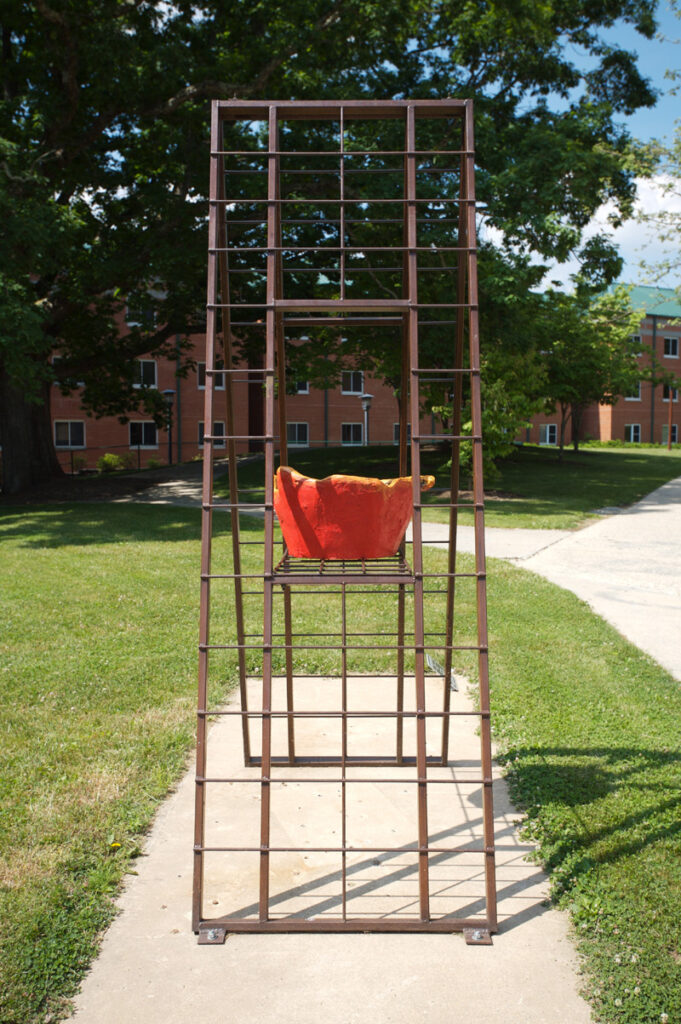
Artist statement
My work is a response to the way I see and experience the world around me.
The lushness of colors, textures, and shapes are more visually appealing to me in fragments than as complete forms. These fragments keep resurfacing in my work as individual elements or in combination. The tactile qualities of surfaces are equally as important to me as are rich, juicy colors; subject matter, or perceived subject matter is incidental.
Juror’s comments
Jan Chenoweth’s Basket in Open Space 2 and Basket in Open Space 3 convey the artist’s strong proclivity towards creating a visual language rooted in nature. While the works appear to be created from wood, fabric, pulp, and other ephemeral elements, they are in fact, quite stable as they are fabricated in steel, concrete, and vivid pigment. Possessing an almost ritual appeal, the viewer approaches the works as if they have arrived at a site in the natural environment, where only remnants of an action remain: that these objects may have had a functional past. The colorful empty baskets balanced on seemingly light armatures begs one to ask what are they meant to collect? And for what purpose? The notion of gathering, collecting, and containing something conveys a quiet effort, and intention that suggests loss, as the dramatic vessels remain empty. The fastidious tactile property employed, underscored by the unnatural color of the baskets, act as metaphorical markers that are further enriched by an artistry that locates itself between craft and folk traditions.
Brace / Pylon
Michael Shewmaker
Hilo, Hawaii
Welded and forged aluminum
9′ x 7′ x 4′ / 14′ x 3′ 4″ x 3′ 4″
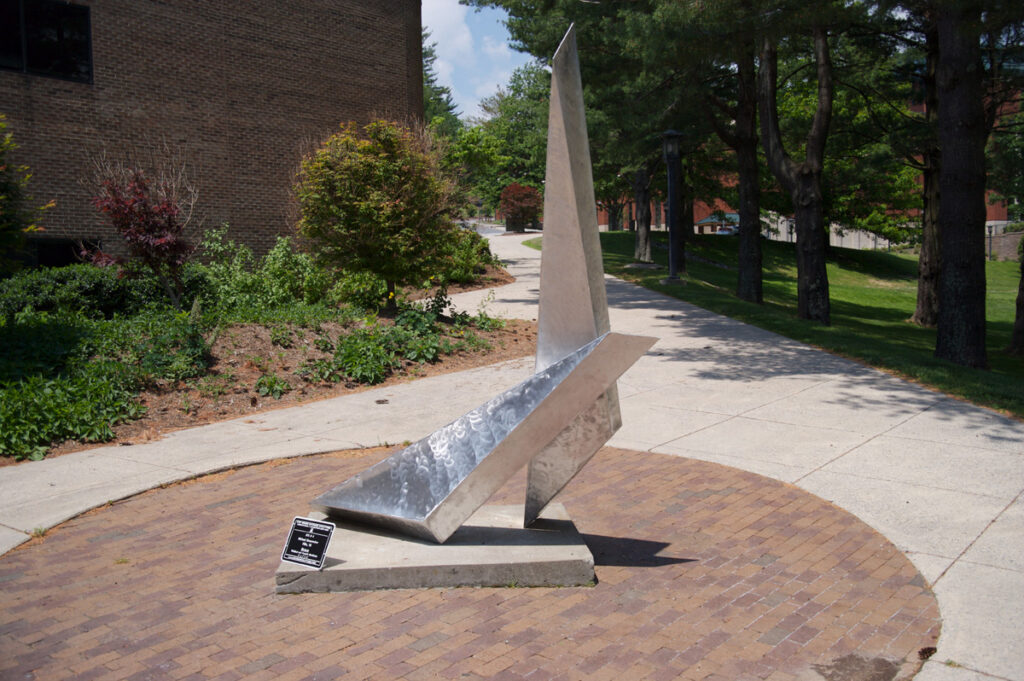
Artist statement
Movement, tension, light and line all play a role in my sculpture. As the light of the day changes, the reflective surfaces of these pieces change in color. On a sunny day they reflect bright blues and greens while under overcast skies they show brooding grays. This gives the work a varied nature.
These elements are constructed from aluminum sheet metal. Boxes are welded together then forged to give each side of the box a more interesting contour. Then the welds are ground and the surface brushed to its finish. The technique makes the work appear more massive than it actually is. As a result the pieces look as if they might be cast rather than constructed.
My work has a certain anger to it that is unnerving to even me. The shapes I am drawn to seem to portray emotional states ranging from pain and suffering to hope and redemption. If the viewer is a little uncomfortable or set back then maybe they have been reached through the art.
Tremendous pleasure derives from the process of creating these pieces. They demand all of the craft skills collected over a lifetime and allow me to put them into product that I feel is worthwhile. I have always believed in and been driven by the tremendous power of abstraction. If I were able to harness a fraction of that power I will have been successful as an artist.
Juror’s comments
Michael Shewmaker’s two superbly forged aluminum works Brace and Pylon seem to harness constantly shifting light and movement. Reflected on the surface of the abstract compilations are pigments from both the grass and sky, alternatively. Bathed in natural light, the works shimmer in the sun and then in fall into shadow to reveal an elegance of matter as essential to the visual experience. The success of both of these works is found not only in the handling of materials, but also in the simplicity of their gesture and form. I selected the two works together as they appear to function as synchronized beacons, or welcoming guides working in tandem.
Grace Protrusion
Jason E. Butler
Tuscon, Arizona
Steel and stainless steel
2′ x 16′ x 5′
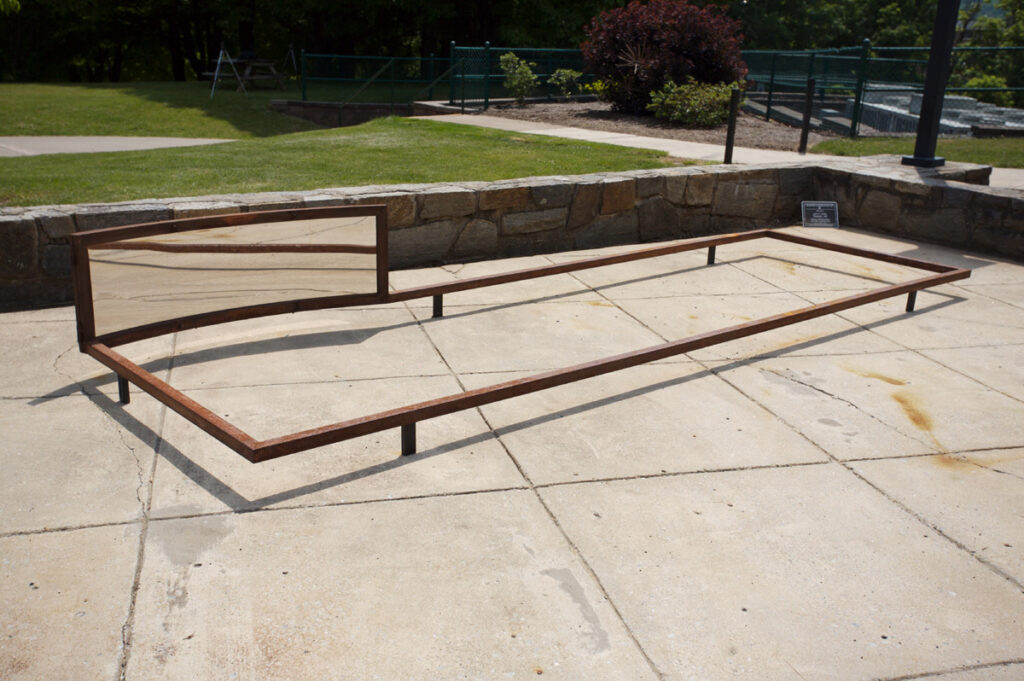
Artist statement
A fascination for polar relationships is central to my sculpture. Distinct formal elements direct the geometry of my forms. I am intrigued by the interplay between straight lines and curved lines, open planes and closed planes, dissimilar materials and distinct colors. The ratios of these details are intentionally disproportionate. Through my sculpture I bring opposites into balanced compositions.
These works allow me to analyze the world – closely observing and contemplating my environment, emotions and other people. I view and order my world in extreme opposites: industrial / organic, positive / negative, open / closed etc.
Much more than a medium for me, precision metal fabrication has become an obsession. I am fascinated with the tools, technique and possibilities of the process. Industrial details from the industry find a place in each piece. These elements are included for their aesthetic, function and association.
Juror’s comments
Jason E. Butler’s Grace Protrusion presents an almost scientific look into formal possibilities found in geometry, line, materials, and perspective. Interested in binary relationships, Butler puts forth work for which the viewer is placed in a position of inquiry, through the interactive nature of the work. In a courtyard, a fabricated steel rectangle is installed low to a cement base. A small, prairie-like garden creates a natural backdrop. Creating a plane hovering just about the grounds surface, mass and density are challenged. A curved, reflective steel plate mounted on one of the rectilinear lines occupies a third of its expanse. The reflective surface produces images of the viewer’s feet and that which is immediately behind them as they step in and out of the plane. In both a two-and-three dimensional expression, a subtly inter-dependency arises as one considers space, and place through opposites; open/closed, negative/positive, light/dark, concrete/abstract, real/imagined. In consideration of these concepts, the body is summoned into the scenario, as one probes perspective and the space we occupy. Butler uses a minimal language to explore more complex concepts. His exacting use of geometry in the three-dimensional realm purposefully distorts fact and most impressively our immediate circumstance, if only momentarily.
Skywalk
Wayne Trapp
Vilas, North Carolina
Powder coated steel
16′ x 11′ x 9′
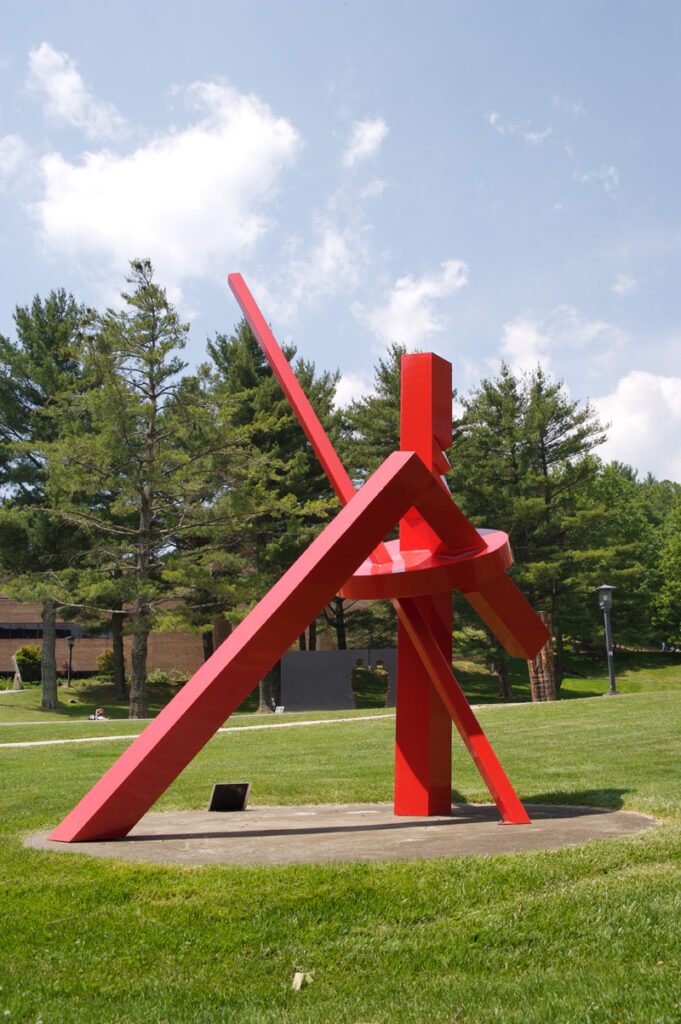
Artist statement
In most cases I get an idea for a sculpture and most often make a scale model, then begin the fabrication process. In the case of SKY WALK (the title is arbitrary) it is the product of a list of corporate commissions. Each specific form evolving into the next one by taking one part of one sculpture as a beginning and adding new elements, thus, inventing a totally new form.
Completing a new large-scale sculpture is one of the most rewarding things in my life…
About the artist
Wayne Trapp, the sculptor, has worked in stone and steel for years, creating lavish–even colossal–outdoor pieces for corporate clients and smaller more particular pieces for his private clientele. His hands, his shoulders, are sore and sensitive with the scars of sculpting, but he can no more give it up than he can give up breathing. He avows that now he sculpts only by commission, but if a fine piece of stone presents itself or a flash of metal catches his eye or a woman turns her head just so, or if the moon is right, well… the dance begins. With unbridled energy and an insatiable passion for everything that crosses his path, Wayne forever seeks interchange, new ground, and a good time.
Wayne lives and operates his studio out of Vilas, N.C., and has works in extensive corporate, institutional and private collections across the U.S. and internationally.
For more information, visit www.waynetrapp.com.
Juror’s comments
Wayne Trapp’s bright red, near-monumental sculpture aptly entitled Skywalk soars in clean, elegant lines and serves as a strong introduction to the exhibition. The steel minimal structure breaks through space to bisect the horizon and encourages the eye upward wherein the sky becomes a natural set to articulate movement, balance, and potential. The simple juxtaposition and as a projection of pure geometry and color, Trapp’s exploration into space and gesture remains abstract but relates to that which is tangible, an impulse for objects, that can be incorporated into our daily lives.
Tethered
Matt Evald Johnson
Easthampton, Massachusetts
Reclaimed wood and steel
6′ 6″ x 7′ 2″ x 14′
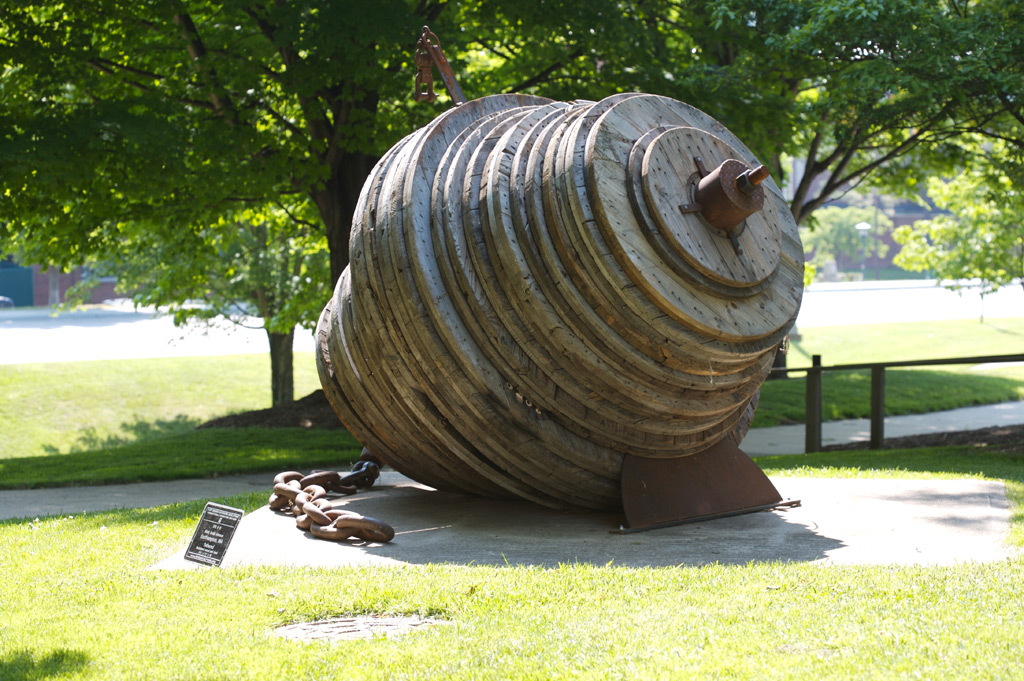
Artist statement
Suffice it to say that I find the individual human’s relationship to stuff, i.e. the physicality if his/her immediate environment, more important than the trifles that occur between human beings as a group struggling to co-exist. “Tethered embodies my artistic ideals and approach to process as purely as I have ever accomplished; accumulation of materials through laborious interaction with them, and a craft-less assembly of those materials through more such laborious interaction. I have sought the most obvious composition available, aware that intentional randomness or asymmetry might betray a decorative intent. But I did allow myself the luxury of ornamentation by the use of the anchor chain which, in the end, re-emphasizes the desired sensations of weight, density and mass as they all come together under gravity – reminding my viewers of the actuality of their physical beings.
Juror’s comments
Matt Evald Johnson’s Tethered is a sculpture that conveys import in its singularity. Incorporating found objects comprised of reclaimed wood and anchor chain, the amassing of such heavy materials are rendered grounded, tethered, and bound. The physicality references the individual and possesses an awe that is simultaneously haunting and irresistible. Undeniably, out of place in such a picturesque setting, Tethered is visceral: the sculpture articulates restriction, resignation, and surrender. The repetition, symmetry, and precision lends an unexpected decorative aspect to an otherwise worn and weathered industrial object. This balancing element imparts new significance to the discarded, randomness, cultural accumulation, and to our physical alignment with such.
This Is Something We Had To Go Through
James Davis
Hattiesburg, Mississippi
Steel and cast iron
7′ x 14′ x 1′
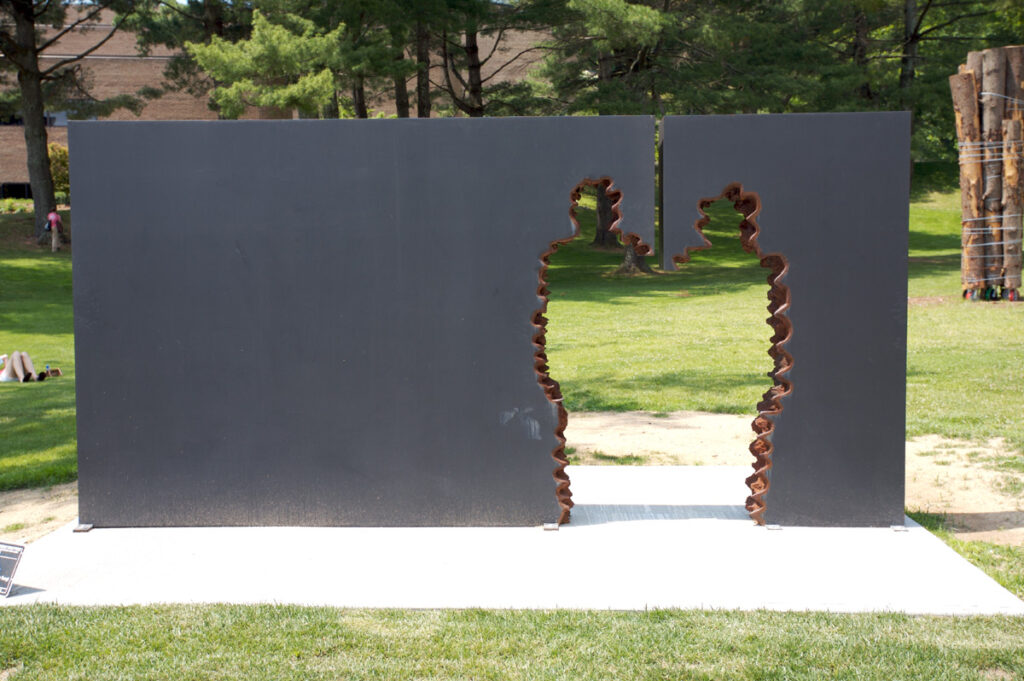
Artist statement
The sculptures in this series deal with personal thoughts and experiences. The ideas derived from thinking about all the things a person has to go through in a life time. These things can be small or large, happy or sad, good or bad. Whatever the feeling may be, these are the things that direct you. Experiences make you who you are.
All of these sculptures hold different meanings for me and for each viewer. I created actual passages that the viewers could go through so they could experience the feeling of going through something difficult. Everyone has to go through things they don’t want to and those are all different for each person. The sculptures are a visual version of some of the things that I was afraid to go through.
Juror’s comments
James Davis’ This is Something We Had to Go Through is the only figurative work in the exhibition. The strength of this work is how it, on one hand, is whimsical and innocent, and on the other conveys intensity and conflict. As the title suggests, the work is about passage, personal experience, and movement beyond. It is curiously optimistic despite its substantive scale and slab-like quality. It successfully conjures struggle, obstacle, perseverance, and memory with irony and wit.
Tumbling Pyramids
Gary Gresko
Oriental, North Carolina
Cement
3′ x 3′ x 3′ each
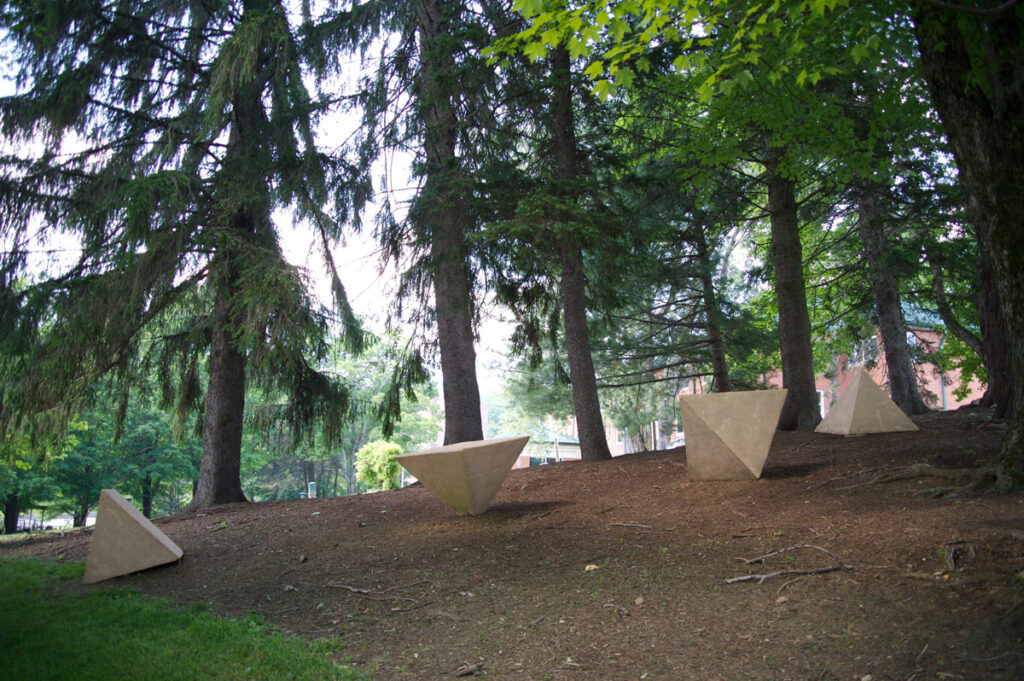
Artist statement
The pyramid is the most stable architectural form known to man. It is a symbol for both physical and spiritual strength and power. However, even these forms can be unstable. They can be viewed from a different perspective. They can be moved.
Pyramids tumbling down a hillside challenge our sense of stability. It is about change. Nothing is permanent. Our world is in flux. And, after all, even the civilizations of the pyramids have tumbled.
Juror’s comments
Gary Gresko’s work Tumbling Pyramids are comprised of four individual concrete pyramids installed in downward increments in a shady, grassy, tree-lined incline. The installation is a fortuitous surprise producing an unexpected intimate experience, especially considering the severity of the grey forms in which one would expect to find installed in a wide-open, manicured landscape or concrete area. Installed in this manner, and when one considers the historicity of these forms themselves, the setting generates a site for contemplation, rest, and even pleasant hesitation. Viewed in this light, a sense of playfulness becomes an unlikely attribute. With a modernist sensibility, Gresko employs the pyramid as a unique schematic for which balance is implied, but not guaranteed.
Uncertainty
Stephen Montague
Columbus, Ohio
Logs, industrial casters and strapping
15′ h x 6’w x 6’d
Site specific
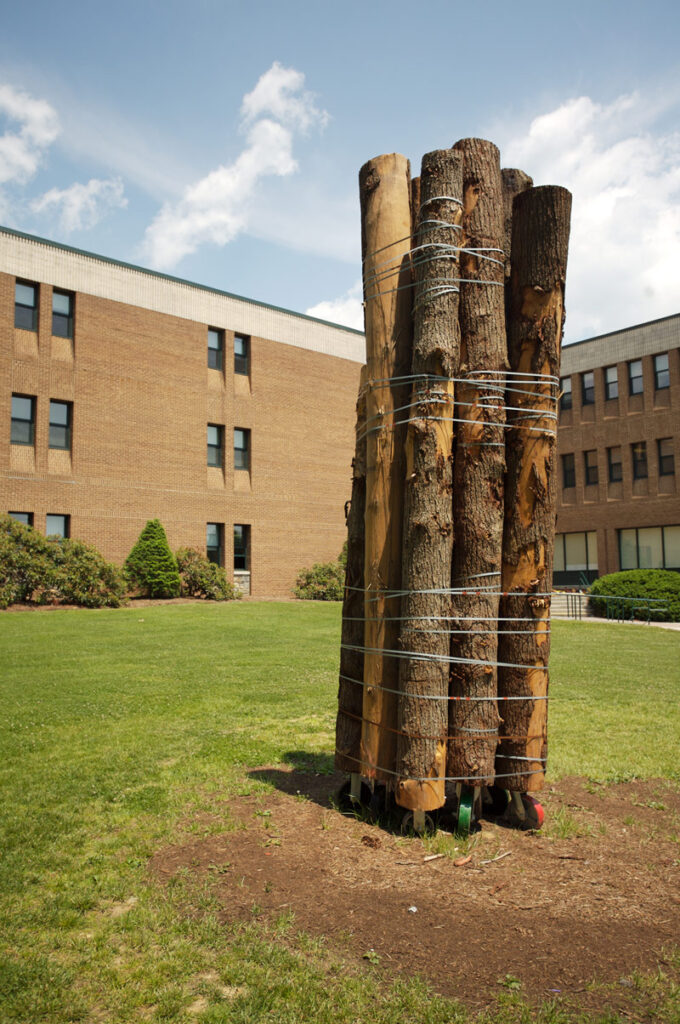
Artist statement
Primarily, most of my work has a contextual association to the environment in which it has been created. My work is not complete unless it has a direct correlation with elements that collectively define the site. The abundance of trees on the campus and the logging industry serve as inspiration for the materials. Process is also an important element of my work. The logs are lashed together in an obvious way as not to hide the reason they are standing. All that said, this sculpture changed from the model I presented. The piece became monumental with a more ephemeral binding. Some inspirations were pick-up sticks, asparagus binding, and the Mobility store (to give mobility to everyone and now anything). I originally intended a whimsical or perhaps political title, Divided They Fall. But as the work progressed, the kinetic potential became apparent and I realized a more encompassing title might be Uncertainty.
Juror’s comments
The images submitted by Stephen Montague demonstrated the artist’s ability to create an interesting site-specific work for the Rosen Competition that continued his exploration into the organic, the environment, and human vulnerability. The artist had trees logged for the installation and tied them together, in the round, and positioned the mass vertically. Balanced on colorful castors, the logs communicate a refinement, which is also threatening. The bound bundles of wood, ominous in scale and content, combined with a kinetic suggestion reminds one of uncertainty, as this monumental work culled from nature can at any moment roll down the hill and become an unpredictable force. The ephemeral nature of the work, entitled Uncertainty reinforce political content as the works’ skyward stretch reaches a threshold precariously balanced on its castors. Perhaps overtly related to the logging industry, Montague also addresses preservation, conservation, and decay with a human element that raises broader implications for viewers to relate to.
Wintering
Arny Nadler
St. Louis, Missouri
Painted steel
10′ x 5′ 4″ x 5′ 4″
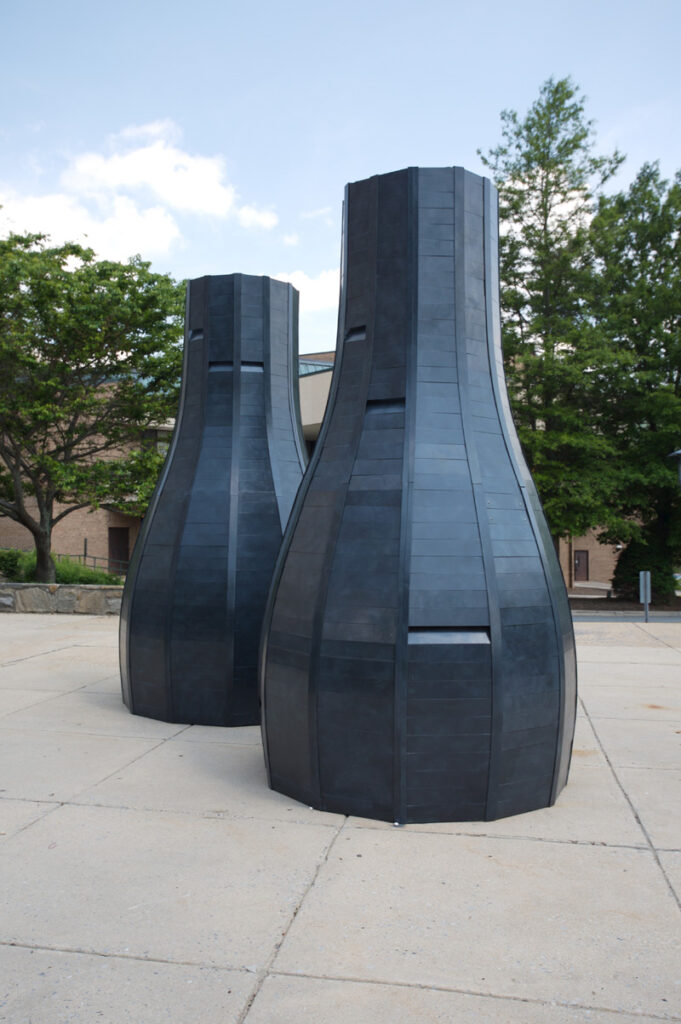
Artist statement
As the son of an immigrant tool and die maker, I was trained at a very young age to look carefully at how things work, to steal with my eyes (as my father put it) while poring over the shops and drafting tables of his practice. The smell of machine grease and molten plastic that defined my Saturday mornings and summer vacations at that factory took an incredible hold, and I am certain that the work I do today is due in no small part to those many hours of looking.
At the heart of my activity as a sculptor is a fascination with form. I am awed when I watch a several ton cantilever bridge slowly rise, pause then lower gently back down of over Des Plaines River in my hometown of Chicago. I find the exoskeletons of crustaceans remarkably alluring. Feats of engineering, both utilitarian and evolutionary, have always appealed to me. This plurality gives me momentum.
If the certain satisfaction of crafting a well-made object were enough, I would undoubtedly fair better making tables and chairs. It is the specificity of construction in the absence of a specific function that intrigues me. Stealing, as my Romanian-Israeli father taught me to do, the skills of the welder, the tailor, the carpenter and, in recent work, perhaps the architect and engineer, I investigate these utilitarian forms stripped of their original practicality.
About the artist
Arny Nadler is an associate professor of art at the Sam Fox School of Design and Visual Arts at Washington University in St. Louis, where he serves as the chair of the undergraduate art program. He has exhibited and lectured at universities, art centers and other venues across the country, including the Evanston Art Center, the Turchin Art Center, Sculpture Key West, the Kingston Sculpture Biennial, Maryland Hall Center for the Creative Arts, Western Michigan University, the Catherine Konner Sculpture Park at Rockland Center for the Arts, Cedarhurst Center for the Arts and the Newport Beach-California Civic Center. Whelm, a site-specific sculpture commissioned by Gallery 210 on the campus of the University of Missouri- St. Louis was built entirely on site using 11,000 feet of steel rebar. Nadler’s work has been reviewed in several publications including Art in America and he was one of ten artists granted a $20,000 fellowship from the Regional Arts Commission of St. Louis in 2013. Additionally, he is a recipient of a George Sugarman Foundation Grant as well as two Sam Fox School Faculty Creative Research Grants from Washington University. He received his MFA in sculpture from Cranbrook Academy of Art in Bloomfield Hills, MI and his BFA in sculpture from Washington University in St. Louis.
For more information, visit arnynadler.com.
About the artist
Arny Nadler’s duo, Wintering stands majestically at the top of a hill wherein the Blue Ridge Mountains create a setting perfect for his presentation. Two large-scaled, painted steel vessels referencing the utilitarian become architectural. The pair resonates as enormous artifacts, resolved, preserved, and imposing in such an elaborated scale. Meticulously crafted from hundreds of steel plates welded together, Wintering takes on several other attributes; it appears to be a woven basket, cast pottery, or fired porcelain. Nadler’s deliberate quoting of other processes that are more delicate combined with references to the domestic (vessel, urn, and vase) is an elegant portrayal, despite a stark surface, darkness, and monumentality. That the artist titled the work Wintering is significant, as it implies physical action as opposed to a still object. This attaches a psychological complexity and inquiry into the foreboding that is articulated through objects and their emotional signifiers. In a mysterious splendor, Wintering functions as a massive aesthetic entity, while also capturing the character of psychological space through our knowledge of objects and their referents.
About the juror
Shannon Fitzgerald is an independent curator and writer based in St. Louis. Recent publications include Larry Krone: Artist/Entertainer (2006), Ruby Osorio: Story of A Girl (Who Awakes Far, Far Away) and Dzine: Punk Funk (2005), Yun-Fei Ji: The Empty City and Michael Lin (2004) all of which accompanied exhibitions she curated for the Contemporary Art Museum St. Louis. She was Chief Curator at the Contemporary Art Museum St. Louis, where she worked from 2000-2007, and curated the thematic group exhibitions Staging: Janieta Eyre, Julie Moos, Zwelethu Mthethwa (2002) and co-curated with Tumelo Mosaka the Contemporary’s inaugural and traveling exhibition A Fiction of Authenticity: Contemporary Africa Abroad (2003). She has curated solo exhibitions of new work by international artists: Larry Krone, Michael Paul Britto, Ruby Osorio, Dzine, Keith Piper, Yun-Fei Ji, Polly Apfelbaum, William Pope.L, and Michael Lin, among others. She received a Bachelor of Fine Arts degree from Massachusetts College of Art in Boston and a Master of Arts degree in Art History and Museum Studies from the University of Wisconsin – Milwaukee. Prior to moving to St. Louis, Fitzgerald worked at the Institute of Visual Arts (inova), University of Wisconsin – Milwaukee. Fitzgerald is currently teaching in the department of Art and Art History at Webster University, St. Louis.
About the curators
Hank Foreman
Hank Foreman serves as Assistant Vice Chancellor of Arts and Cultural Affairs as well as Director and Chief Curator of the Turchin Center for the Visual Arts for Appalachian State University. He obtained his M.A. in Art Education from Appalachian, having completed undergraduate studies at the University of North Carolina at Charlotte, with a concentration in Painting and Sculpture. His duties include the administrative responsibilities for An Appalachian Summer Festival, the Performing Arts Series, Farthing Auditorium and the Turchin Center for the Visual Arts.
During his tenure at Appalachian State, Foreman has taken part in the organization of numerous exhibitions, including the associated lectures, symposia, and publications. He has worked closely with the university’s Department of Art, and a wide variety of other campus and community groups, to make gallery resources available to all. One of his earliest exhibitions at Appalachian, Views From Ground Level: Art and Ecology in the Late Nineties, brought internationally acclaimed artists, historians, and critics to the campus and received national attention.
Foreman is also an exhibiting studio artist, and participates in regional and national conferences as a presenter and panelist.
Brook Bower
Brook Bower serves as the assistant curator and administrator for the Turchin Center for the Visual Arts and its staff. She received a BS in Art Management and a BFA in Ceramics from Appalachian State University’s Department of Art in 2001. Bower’s professional activities include curating exhibitions, lecturing, consulting for competition management, serving as a juror for local competitions, mentoring future art management students and managing several national art competitions including the Rosen Sculpture Competition, the Halpert Biennial and the Appalachian Mountain Photography Competition. Bower also serves as the Acting Registrar, providing collections management support for the Turchin Center’s Permanent Collection containing 1,481+ objects and managing the Intra-Campus Loan Program.
Following her undergraduate degrees, she has concentrated on furthering her education by attending conferences, courses and workshops expanding her knowledge of curatorship, exhibition design, and collections management. Bower recently participated in the 2011 SEMC Jekyll Island Management Institute and is currently seeking a Master of Visual Arts Administration, with a focus in curatorial studies, at New York University in New York City. She serves on multiple committees that concentrate on community enhancement utilizing the visual arts and serves as the faculty advisor for the Arts Management Organization (AMO). In addition, Bower is an active exhibiting artist.
A Special Thanks from the Curator
The following people have been instrumental in lending their assistance and expertise to make this program a success: Hank Foreman, Director & Chief Curator; Brook Bower Greene, Assistant Curator & Project Director; Tasha Nunn, Exhibitions Coordinator for the Turchin Center; Paul Grant, Guest Services; Sara Gordon, Gallery Intern; Gallery Assistants: Dayna Seman, Maloree Sheets, Jennifer Livingston, Blair Brown, Carrie Webb, Tyler West, Bradley Pearce, Reese Bolton and James Easley; Gary Profitt of Boone Crane; Staff of the ASU Safety Office: Beth Clark and Evan Rowe; Staff of the ASU Grounds Crew: Jim Bryan; The Staff of The Office of Design and Construction: Clyde Robbins and Patrick Beville; Department of Art: Sonny Struss, Sean Matthews and Olu Amoda; Photographers: Beck Long, Installation Photographer and Troy Tuttle: Sculpture Photographer.

